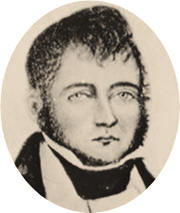Captain Thomas Boyle (1775 -1825)
Irish-born American Patriots, Baltimore Businessman, Privateer Captain during the War of 1812/1814
 Thomas
Boyle was born on June 29, 1775, in Marblehead, Massachusetts of
Irish parents. Little is known of his early life other than for some
accounts that his family were Irish Lutherans who came from the
northwest of Ireland - probably Donegal where many of the Boyle
clans had settled.
Thomas
Boyle was born on June 29, 1775, in Marblehead, Massachusetts of
Irish parents. Little is known of his early life other than for some
accounts that his family were Irish Lutherans who came from the
northwest of Ireland - probably Donegal where many of the Boyle
clans had settled.
Boyle first went to sea at the age of ten as a ship's boy on a merchant vessel commanded by his father. By the time he was seventeen his name was listed in the Registry of Ships of the Baltimore Custom House as the captain of the Hester, a schooner owned by John Carrere who was in the business of importing sugar and coffee from the West Indies and South America.
In 1794, Boyle moved from Marblehead, Massachusetts to Baltimore, Maryland. Around that time, he married Mary Gross, a widow, with whom he had five daughters.
Aside from his shipping interests, Boyle was a successful businessman with various business and real estate investments in the city of Baltimore. By 1808, he commanded or owned twelve merchant ships that plied the trading routes between Caribbean and Europe buying and selling goods.
In April of 1808, Boyle was appointed to the rank of captain and company commander in Baltimore's 51st Regiment.
When President James Madison declared war on England in June of 1812, his undertaking was indeed formable as England was a world power who ruled the waves with a naval fleet of over one thousand vessels. By declaring war, Madison intended to right numerous indignities suffered by the U.S at the hands of its former master. The most egregious of these was England's self-espoused right to hijack American merchant ships on the high seas and snatch members of the crew to replenish its short supply of able-bodied sailors to help man it's navy. Other grievances included Britain's attempt to prevent U.S. trade with France and their refusal to settle disputed territory along the Canadian border.
The U.S Navy at that time was no match, in numbers, for the Royal Navy. Nonetheless, the U.S Navy, such as it was, won most of the major sea battles of the war.
In order to supplement the U.S. Navy fleet of seventeen, or so, war ships, Madison granted Letter of Marque and Reprisal to privateers or private ship owners. Their mission was to harass the Royal Navy, capture and disrupt England's merchant fleet on the high seas; a tactic that worked far better that the most optimistic expectation. The spoils of war was shared between the privateer and the U.S treasury.
In July of 1812, Boyle resigned his commission to take command of the Comet, a schooner, built by Thomas Kemp a renowned Fell Point shipbuilder. The Comet, with its 14 guns and a crew of 110 seamen and marines sailed out of the Chesapeake in July of 1812 for the West Indies on its first cruise. By the time he returned to port in October he had captured four English vessels and taken their crews prisoners. As was the common practice with captured vessels, Boyle designated members of his crew to sail each of the vessels back to U.S ports where the spoils were divided up between the ship’s owner and the U.S. treasury.
On his second cruise off the Brazilian coast, which lasted from November 1812 through March 1813, Boyle and his crew captured a total of five English merchant vessels. During that cruise he came upon a Portuguese man-o-war escorting three English merchant vessels. Such was his daring, that not alone did he severely damage the man-o-war but captured the three vessels being escorted. After that encounter the Portuguese man-of-war, after limping back to port, was scrapped due to the damage inflicted by the Comet.
During the Summer of 1813, Boyle and other privateers were prevented from leaving port due the Royal Navy’s blockade of Chesapeake Bay. During that period, Boyle accepted a warrant as sailing master in the U.S. Navy, which lasted from April through September of 1813, he helped protect American commerce on Chesapeake Bay.
In October of 1813, the Comet on her last cruise, with Boyle in command, sneaked through the blockade in heavy weather. During that cruise to the West Indies, Boyle and his crew captured 20 more ships before returning to the U.S. in March 1814. On this occasion he returned to Beaufort, North Carolina where he departed company with the Comet.
From North Carolina he made his way to New York, where he took command of the privateer Chasseur, of which he was part owner. The Chasseur was built at the Thomas Kemp shipyard in Fells Point as was the Comet. The Chasseur, a much faster schooner than the Comet, was equipped with sixteen long twelve-pounders and carried a hundred officers, seamen, and marines., It was never out-sailed in fair winds or foul weather.
On his first cruise as master of Chasseur in 1814, Boyle sailed east to the English Isles, where he harassed the Royal Navy and the English merchant fleet. During that cruise, Boyle captured or sank eighteen vessels before returning to New York in October of 1814. His most daring exploit was to proclaim a blockade of all English and Irish ports. His proclamation, which was posted in Lloyd's Coffee House in London, was delivered by way of a captured merchant vessel. English merchants were taking his proclamation seriously causing shipping and insurance rates to soar. In honor of Boyle and his crew tenacity and daring, they were greeted by large crowds along the shores of the Chesapeake. The Chasseur earned the nickname "The Pride of Baltimore."
The English made extraordinary efforts to capture Boyle. The Chasseur escaped numerous traps set by the Royal Navy. He and his crew were such accomplished sailors that they could outgun, out-sail and outrun the best the English could throw at them. So great was the damage caused by his blockade that the English Admiralty was forced to call vessels home from the American war to guard merchant ships sailing in convoys. They dearly wanted to capture that 'Yankee rogue' Irishman.
In December of 1815, the Chasseur put to sea on course for the West Indies on what was to be her final cruise as a privateer. Again, she capture a number of merchant vessels before spotting and chasing what appeared to be a weakly armed coaster with three mounted guns. Instead, what he encountered was the St. Lawrence a Royal Navy cruiser with 10 hidden guns. Undaunted, Boyle raced to the attack, and, after a sharp 15-minute fight, the St Lawrence surrendered.
Little is known of Boyle's life after the war. He settled in Baltimore and presumably returned to the mercantile service. He died and presumably was buried at sea in 1825.
Boyle was a stalwart amongst a remarkable band of privateer’s who served America with honor and distinction. They took on the most formidable naval power of its time and demonstrated to the world that men with a just cause and conviction can overcome, what seemed, insurmountable odds. He treated his crew members with respect and was blind to their place of origin or the color of their skin. He took many prisoners during the war and treated all of them with respect and dignity.
He was, as were many other distinguished Irish Americans, a credit to his country and his Irish roots and an inspiration to countless thousands of Irish and Irish American men and women, who down through the centuries since, bore the torch of freedom.
Contributed by Tomás Ó Coısdealbha

